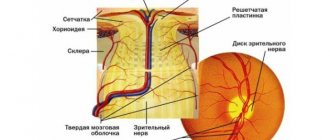Mechanisms of psychological defense. An article about psychological defenses in order to begin to understand what it is and how it works
The psyche functions as an integral energy-filled system. In order to describe exactly how the psyche works, the concept of defense mechanisms of the psyche or “psychological defense mechanisms” is introduced. If you went to study to become a psychologist, then during one of the classes the teacher will give you a piece of paper listing the mechanisms of mental defense and their description. In rare cases, at the seminar they will give you some examples, metaphors, or draw something like a lock on a river - this is already a PhD level in psychology. Often, understanding these mechanisms does not provide any benefit, that is, it is not applicable in practice. The purpose of this article is to clarify what it is, how it works, and quite a bit - why knowledge about mental defenses is used in practical psychology.
In Dali’s painting: protection in the form of slingshots supports “personality”.
Sigmund Freud was the first to highlight their work and describe them. Noticing the recurring features of the patient’s behavior, the psychoanalyst determines which protective mechanisms dominate in the patient’s psyche. Defense mechanisms allow one to resist therapy, on the one hand, and on the other hand, they serve as information on how to continue working with the patient. We can understand exactly what protective mechanism is being updated from communication with a person, by his speech, facial expressions, and gestures. From psychoanalysis, the protective mechanisms of the psyche, with changes in their meaning, migrated to the theory of Gestalt therapy and began to be called “methods of interrupting contact.”
Mental defenses are neither good nor bad, since in the model of the psyche they serve as certain barriers that allow one to regulate emotions, feelings and experiences both consciously and unconsciously, that is, automatically. By being aware of our defense mechanisms, we can regulate emotions, increase our resilience to stress, and increase our effectiveness in functioning socially and alone.
If any mental defense mechanism does not work correctly, the psyche will experience emotional overload, or will function in a “smoldering”, weak mode - as happens in depression, or, more precisely, in an asthenic state.
If the psychological defense mechanisms function normally, we say that the person is adequate.
In everyday understanding, a mechanism is something unchangeable, permanent. The defense mechanisms of the psyche are not constant, their function changes, depending on the situation - in communication with loved ones, for example, their functions weaken. This all means that protective mechanisms - a term that does not reflect the content - in the strict sense are protective functions. At the same time, there is both a function and a mechanism, a wave and a particle, as in quantum mechanics. In a mathematical metaphor, defense is perhaps a derivative of a certain emotional tension.
In an aggressive and excited state, a person directs his muscles, arms and legs to protect the psyche - the psyche sometimes has to defend itself by actively using parts of the body. In a small child, mental defenses are weak, their functions are largely performed by the parent, and if the parent has healthy mental defense mechanisms, then the child develops his own mental defense mechanisms over time.
Mechanisms of psychological defense of the individual is, at first glance, a synonym for the phrase mechanisms of psychological defense. But this synonym, as well as its formulation in the teaching of general psychology, can be confusing. For example, is the identification mechanism related to fusion (confluence in the theory of Gestalt therapy) and what is its place in regression? What is the relationship between the phenomena that stand behind these words? At first glance, these are related concepts. But regression is a general shift in the functioning of all psychological defenses to a state earlier in a person’s age; it is not an independent, separate mechanism, but a weakening of the work of all mental defense mechanisms, their transition to a primitive state, in a situation of experiencing violence or severe stress, for example. Open any public page for asthenics: - blanket, tea, chocolate, well, you get the idea.
What are psychological defense mechanisms
It’s worth starting, perhaps, with the definition of psychological defenses. They represent certain unconscious mechanisms that serve to cope with unpleasant, traumatic experiences and to redirect impulses arising in connection with events that the psyche cannot effectively process. As a result, negative experiences are suppressed, internal conflict or conflict between emotional reactions is erased due to distortion and deformation of perception.
There are a large number of mental defense mechanisms, and we have written about them before. For example, our blog has good materials about sublimation, auto-aggression and other behavioral defense mechanisms. What they all have in common is that they help the ego to ward off dangerous desires and impulses that can lead to painful feelings of anxiety, depression or shame. Triggers for psychodefenses can be both internal and external stimuli, that is, internalized internal prohibitions or events in the external world. A person often has one or two or three main psychological defense mechanisms, but he can use others, completely unconsciously. Fortunately, psychological defenses are dynamic and reversible.
Having defined the concept of psychodefenses, let's consider their model within the framework of the Life Style Index (LSI) and the Plutchik-Kellerman-Conte system, as well as this mental diagnostic technique itself.
Characteristics
Psychoanalysts Calvin Hall (English)Russian. and Gardner Lindsay (English)Russian. identified two main characteristics of defense mechanisms:
- denial or distortion of reality;
- action on an unconscious level.
The perception of not only internal, but also external reality is subject to distortion and denial: “The “I” can protect itself both by ignorance of the existence of certain needs and instincts, and by ignorance of the existence of external objects.”
[4]. For psychotherapy, the first characteristic is especially important, since it is this that can lead to social maladjustment and other problems.
Most often, people use defense mechanisms not one at a time, but in combination. In addition, most people tend to “prefer” some defenses over others, as if their use were a matter of habit.
Life style index and the Plutchik-Kellerman-Conte model of psychological defense mechanisms
In the model of Plutchik, Kellerman and Conte, it is believed that the protective mechanisms of the psyche are formed in order to help the individual cope with internal and external stresses, and they are closely related to primary emotions and acute experiences. It is to cope with one of the eight basic emotions that a defense mechanism develops. Thus, there are 8 psychoprotections. They are characterized by similarities and polarities, and like binary pairs of emotions, opposite pairs of defensive reactions of the psyche can be distinguished. A person can use any combination of defenses, but it is often the case that there are one or two main ones, and by identifying them it is possible to determine a personality type or disposition.
This is the essence of the method of mental diagnostics of IHS - to identify the personality type and emotions characteristic of the individual, along with defense mechanisms. Habitual behavioral mechanisms and inadmissible emotions shed light on the characteristics of a person’s psycho-emotional structure, the degree of his maturity and awareness. The test itself looks like a list of statements about oneself with which the individual must agree or disagree. After all statements are answered, the number of positive responses is counted.
The identified mechanisms are assigned quantitative values depending on the manifestation and intensity of the ego’s defensive reaction. Thus, the intensity of the defense is determined - the more statements on a given psychodefense a person agrees with, the higher this indicator. If the overall intensity of all defenses is above 50% (half of all statements in the questionnaire are characteristic of a person), we can say that the person has unresolved internal and external conflicts. The most adapted and mature people use the least number of defense mechanisms, while people who are maladapted to life and infantile, internally immature, tend to use defense mechanisms to a much greater extent.
So, in total there are 8 defensive reactions of the psyche, each of which “protects” it from the painful experience of some specific basic emotion. Let's now move on to consider defense mechanisms, what each of them is and how it can manifest itself in behavior.
Introduction
In everyday life, we often encounter stressful situations. Therefore, from childhood, special mechanisms are formed that can protect our psyche and, accordingly, ourselves from injuries that can be caused by real life situations. But at the same time, these mechanisms prevent a person from realizing his misconceptions regarding his own character traits and motives of behavior, which often makes it difficult to effectively resolve personal problems.
Due to all of the above, it is necessary to know the essence of these mechanisms in order to prevent irreversible consequences.
What emotions does each psychological defense protect against?
Let us repeat the essence of the defense mechanism: when a dangerous stimulus arises that threatens to destroy mental balance, the concept of oneself and the world, self-respect or consistency of views, the psyche defends itself from it. The emotions caused by the impulse, and the accompanying strong conflict between one’s own parts or with the outside world, are pushed out and redirected. The ego’s defensive reaction serves to extinguish unwanted emotions and maintain the integrity of one’s perception. In the process, information is significantly distorted and the person adapts to the situation through redefinition of what is happening and interpretations that are convenient for the psyche. And the natural impulse does not find its way out, melting into uncharacteristic defensive behavior.
Briefly, the protective mental mechanisms for leading reactions look like this:
1
Negation
With this mechanism, unwanted and frustrating circumstances, emotions, facts are denied and not recognized. That part of the information that disturbs inner peace and balance or causes anxiety and pain is not missed or perceived by the person. There is a break with reality and a clear distortion of some of its aspects.
For example, it can be very painful for a person to accept mean or cruel manifestations of loved ones, since they go against his established ideals and beliefs, and to protect his psyche, a person resorts to denying “inconvenient” facts.
2
crowding out
A defense mechanism similar to denial, in which unacceptable internal impulses, desires, feelings, thoughts are repressed into the subconscious and become completely unconscious and unconscious. However, despite this, the internal conflict remains, and it is accompanied by psycho-emotional tension, unpleasant experiences and bodily reactions. Undesirable and inappropriate emotions, thoughts and qualities are absolutely not recognized by the individual, but outwardly manifest themselves in the form of emotional, neurotic and somatic symptoms.
Thus, a person can repress from consciousness some of his impulses or qualities of character that he considers bad, unacceptable, undesirable, but his psycho-emotional structure and physical body experience this conflict and give a noticeable reaction to others.
3
Regression
This psychoprotection represents a return to an earlier stage or state when there were no threatening and disturbing stimuli, to what is perceived as a safe and controllable slice of reality. It can be expressed as a distinct “falling” into childhood, infantilism, helplessness and a search for support from others, “adults”. In such cases, a person may begin to speak in a child's voice, using words, facial expressions and movements used in childhood.
Regression can also manifest itself as the replacement of complex tasks facing a person and unsettling him with simpler, familiar and understandable ones. For example, a person may begin to do something else, mechanical and uncomplicated, such as cleaning the table or the apartment, instead of dealing with the immediate problem. Or he may resort to impulsive actions, trying to cope with anxiety, frustration or other strong experiences by giving in to his addictions, easy pleasures, and simple available activities.
For example, when faced with a serious problem at work or a conflict with an important person, a person does not deal with this situation and does not look for a solution, but redirects his energy to shopping, driving fast, or receiving support and positive emotions through correspondence and chats.
4
Compensation
A person can use this defense mechanism when he wants to smooth out his shortcoming, undesirable quality or feeling in some other way. Often in such cases, other people's thoughts, traits, character traits, behavior patterns and values are borrowed, but they are not rethought and not integrated into the personality. They do not become “native”, incorporated into the personality, but remain alien elements.
Another type of compensation occurs when a person compensates for some of his weaknesses or frustrations in one thing with achievements, competence or a leading position in another. Examples include situations where a weak and sickly teenager overdevelops his intellect or a sharp tongue, or cases where, unable to establish a career, a person throws himself headlong into family life, spiritual quests, or the creation of his ideal body.
5
Projection
Projection is based on attributing to other people those qualities, thoughts, impulses and feelings that the individual considers unacceptable and unworthy. With the help of this defense mechanism, the ego is protected from recognizing such negative characteristics in itself and the unpleasant emotions that follow. As a result, all such “bad” qualities and manifestations are noticed in others (regardless of their objective presence) and are condemned. The image of oneself as good and blissful is preserved.
Another version of projection occurs when sharply positive properties, values, thoughts and feelings are attributed to people from one’s close circle, and due to this the person is elevated. “Since I am friends with such wonderful people, how wonderful I am!” a person with this type of projection might think.
6
Substitution
In the case of such disapproved emotions and impulses as aggression, anger, rage, a person can redirect them from the source to a more accessible and safe object. As a result, the person shifts the application of these emotions to an innocent person who is harmless and will not fight back. This method of psychological defense can often be observed when people show unreasonable aggression towards random people and somehow relieve their emotional stress at the expense of those who have nothing to do with them. In this case, the problem is not solved and the person does not adapt to the stimulus that caused strong negative emotions.
7
Intellectualization
Better known as “rationalization,” this defense mechanism is characterized by the fact that a person finds intellectual, reasonable, logical arguments and attitudes to reassure himself. With its help, a person can reduce the importance of what he is unable to receive and smooth out internal conflict.
Resolution of an unpleasant, frustrating situation is carried out on a mental, abstract level and takes away from the feelings, frustrations and pain experienced. With such a defense mechanism, a person can logically justify to himself that, for example, his job is not so bad, others have it even worse, and one should be grateful, avoiding internal conflict and true feelings - dissatisfaction and disappointment in one’s work.
8
Reactive education
A type of psychological defense where an unpleasant and unacceptable impulse, quality, thought or feeling is reversed and redeveloped. Thus, aggressiveness and indifference can give rise to emphasized politeness and courtesy. Excessive sociability can sometimes be a reactive formation in relation to natural isolation.
These are the 8 protective mechanisms in the individual housing construction model. All of them, although they represent a way of adapting to the situation and stimuli, show the degree of maladaptation and infantilism of the individual. The more a person relies on his psychological defenses and the more limited his ways of reacting to frustrating and stressful circumstances, the higher the degree of his maladjustment in life and personal immaturity.
Rules of conduct for people wearing protective gear
⇐ PreviousPage 4 of 6Next ⇒Structures
Those taking refuge are required to comply with the internal regulations of the protective structure, as well as provide assistance to the commandant in maintaining order and resolving life support issues.
Those taking refuge are required to have personal protective equipment (PPE), a supply of food in plastic packaging, toiletries and other essential items (medicines as needed). Everyone must keep PPE ready for use.
It is prohibited to : bring flammable and strong-smelling substances into the protective structure; bring animals; walk unnecessarily, make noise, smoke, use open fire; leave the protective structure without the permission of the commandant.
Everyone in a protective structure, despite the complexity of the situation, is obliged to show psychological stability and assist others in this. This is largely facilitated by information about the environment that people receive from outside via radio broadcasts.
Food and water intake in protective structures is carried out in an organized manner. During a long stay in protective structures, the commandant organizes shifts of rest for people in their lying areas.
The exit of people from the protective structure is carried out by an alert signal or by a command from the object's control panel. In their absence, the decision on the exit of people can be made by the commandant of the protective structure, having assessed the general situation.
People exit in the following order. The first to come out is the dosimetrist chemist with instruments. He takes measurements and inspects the surrounding area. Based on the measurement results, the commandant makes a decision on the order of withdrawal of people. First, several people come to the surface to help those who cannot move independently, then children, the elderly, and then everyone else come out.
The decision on further actions of those being sheltered at the moment is made in accordance with the current situation.
| Name of structures and vehicles | Kosle |
| 1. PRODUCTION AND ADMINISTRATIVE BUILDINGS | |
| Industrial one-story buildings (workshops) | |
| Industrial and administrative buildings, multi-storey with large glass areas | |
| 2. RESIDENTIAL BUILDINGS | |
| Stone houses: | |
| § one-story | |
| § two-story | 15 — 20 |
| § three to five storeys | 20 — 40 |
| § multi-storey | 40 — 70 |
| Wooden houses: § one-story | 2 — 3 |
| § two-story | 7 — 9 |
| 3. BASEMENTS | |
| Basements of stone houses: | |
| § one-story | |
| § two-story | |
| § multi-storey |
| Name of structures and vehicles | Kosle |
| Basements of wooden houses: | |
| § one-story | |
| § two-story | |
| 4. SIMPLE COVERS | |
| Open cracks, trenches (not decontaminated) | |
| Open cracks, trenches (cleared of radioactive dust) | |
| Covered cracks | |
| Cellars, underground storage facilities | 40 – 50 |
| 5. PROTECTIVE STRUCTURES | |
| Anti-radiation shelters | 50 or more |
| Shelters | 1000 or more |
| 6. VEHICLES | |
| Cars, buses, trolleybuses | |
| Railway platforms | 1,5 |
| Covered freight cars | |
| Passenger carriages | |
| Cabins of bulldozers, tractors, excavators | |
| Armored personnel carriers | |
| Tanks |
Individual protection means.
Personal protective equipment (PPE) is intended to protect a person from the ingress of radioactive substances, toxic substances and bacteriological agents into the body, skin and clothing.
.
Respiratory, eye and facial protection
PPE for respiratory organs, eyes and facial skin includes:
· filtering gas masks: for adults - GP-5, GP-7, GP-7V, GP-7B, etc.;
· for school-age children - PDF-Sh and PDF-2sh;
· for children aged 1.5 to 7 years - PDF-D and PDF-2d;
· for children under the age of 1.5 years, a children's protective camera of the type KZD-1, KZD-2, KZD-4 (5.6) is intended;
· insulating gas masks of type IP-4 and IP-46 , oxygen-insulating devices of type KIP-5 and KIP-8;
· respirators type ShB-1 (“LEPESTOK”), R-2, R-9 , etc.;
· the simplest means of respiratory protection: anti-dust fabric masks (PTM) and cotton-gauze dressings (VMP).
The principle of operation of a filter gas mask
PURPOSE AND DEVICE OF FILTERING GAS MASK GP-7 AND GP-7V.
Filtering gas mask GP-7
P is intended to protect the respiratory system, eyes and facial skin from exposure agents, radiation exposure and BS,
GP-7V, in addition, ensures the intake of water in a contaminated atmosphere.
GP-7 complete set:
· front part (1),
· filter-absorbing box (2),
· protective knitted cover (3),
· anti-fog films,
· bag for carrying a gas mask.
GAS MASK GP-7B: provides protection for the respiratory system, eyes and skin of a person’s face from aerosols, vapors and gases of toxic chemical warfare agents (BTCW), radioactive substances (RS) and biological aerosols (BA), as well as emergency chemically hazardous substances (HAS) , including ammonia and organic compounds with a boiling point less than 65°C (organic low-boiling, low-sorbing substances).
According to its design and technical characteristics, it
is an analogue of the GP-7 gas mask.
| Weight of gas masks (assembled, without bag) | no more than 950 grams |
PREPARING THE GAS MASK FOR WORK:
· selection of a face mask,
· comprehensiveness check and inspection,
· gas mask assembly, gas mask adjustment,
· checking for tightness,
· packing in a bag.
GP-5 To select the required height for a helmet-mask, you need to measure your head along a closed line passing through the crown, cheeks and chin. Measurements are rounded to 0.5 cm. For measurements up to 63 cm, take zero height, from 63.5 to 65.5 cm - first, from 66 to 68 cm - second, from 68.5 to 70.5 cm - third, from 71 cm or more - fourth.
RULES FOR USE OF FILTER GAS MASK
"MARKING" "READY " " COMbat
»
The gas mask is removed by the command: “GAS MASKS
TAKE OFF!"
The additional cartridge DPG-3 is designed for protection against hazardous chemicals and is used with civilian gas masks GP-7, GP-5, PDF-D and others.
Time of protective action of DPG-3
⇐ Previous4Next ⇒
Emotions and their inherent defense mechanisms
As we know, the above protective mechanisms fit into Plutchik’s psycho-evolutionary model of emotions. Moreover, each of the defenses is “responsible” for coping with a specific emotion. Let's take a closer look at this side of the theory.
The relationship between emotions and defense mechanisms forms a system:
- Joy is the translation of this reaction into another, often its opposite, suppression of pleasant sensations from an object and situation (reactive formation). For example, this could be a ban on pleasant experiences or pleasure, or disgust. Overestimation of the stimulus “Everything about this is disgusting.”
- Sadness (from the loss of a significant object or self-esteem) - compensation, for example in the form of fantasies or expansive behavior. Interpretations and rethinking “But I... Still I... Someday I...”
- Anger is a replacement. It can take the form of redirected aggression, self-aggression, and destructive behavior. Interpretation: “That’s who is to blame for everything.”
- Fear – suppression, avoidance. The stimulus is overestimated in “This is unfamiliar to me.”
- Anticipation/expectation - intellectualization, that is, rationalization, the desire for control through logical explanations, analysis and introspection - “Everything is explainable.”
- Surprise - regression, that is, a return to an earlier psychological state, infantilism. Interpretation: “You must help me.”
- Disgust is a projection, the transfer of one’s own unacceptable properties or inferiority onto others. Expressed in particular criticality, demandingness, and hostility. Revaluation of the stimulus “All people are vicious.”
- Acceptance is denial, ignoring certain facts that conflict with one’s own values, ideals, perceptions, peace of mind, which allows one to continue to accept others.
To summarize, we can say that the Life Style Index (LSI) system, introduced in 1979, is a working tool for diagnosing the psychosocial characteristics of a person and his typical psychodefense mechanisms. This model, created by Plutchik, Kellerman and Conte, identifies 8 main psychological defenses. They correspond to Plutchik's 8 basic emotions and are developed to best experience a dominant or strong emotion. An individual may have any number of defense mechanisms, which are unique ways of adapting to the situation.
Notes
- Freud S., “ The neuro-psychoses of defense
” - Freud A., “Psychology of the Self and Defense Mechanisms”, Chapter 4: “Defense Mechanisms”
- Nikolskaya I. M., Granovskaya R. M.
Psychological protection in children. - M.: Rech, 2006. - P. 10. - 342 p. — ISBN 5-9268-0457-4. - Hall C. (English) Russian, Lindsey G. (English) Russian. Theory of Personality
. - New York: John Wiley, 1957. - P. 11. - McWilliams N.
chapter 5: “Primary (primitive) defense processes” and chapter 6: “Secondary (higher order) defense mechanisms” //
Psychoanalytic diagnosis: Understanding personality structure in the clinical process
= Psychoanalytic diagnosis: Understanding personality structure in the clinical process. - M.: Klass, 1998. - 480 p. — ISBN 5-86375-098-7.
Summarizing
Despite all its complexity and confusion, the model of defense mechanisms by Plutchik, Kellerman and Conte can be a good practical tool for greater awareness and effectiveness in life. We invite you to once again go through the list of possible psychological defenses and answer the questions:
- What defense mechanisms have you noticed in yourself?
- Is there one among them that you use more often than others?
- Which of these reactions do you find difficult to control and be aware of when you resort to them?
- And most importantly, what other ways to cope with unpleasant events, feelings or your shortcomings are there? How else can you react and behave? What approach or behavior will be most effective and beneficial in the long term?
The more aware you are of your unconscious psychological defenses, the less they control you and are automatic. This way, it is possible not only to choose the most optimal behavior, but also to become the master of your reactions and your life. If you are interested in developing the skills of awareness and management of your emotions, we draw your attention to the online program “Mental Self-Regulation”. This course teaches the ability to control and harmonize your mental states, which improves your quality of life.
We wish you good luck!
We also recommend reading:
- Reframing Your Dark Side
- Hakomi Therapy
- Psychosomatics or whether our emotions affect health
- Psychological triggers
- Robert Plutchik's Theory of Emotions
- Sublimation in psychology
- Fundamentals of neuroeconomics: how do we make decisions?
- Intelligence: definition, development and degradation
- Defense mechanisms of the psyche
- Behavioral mechanisms
Key words: 1Cognitive science, 1Psychoregulation







